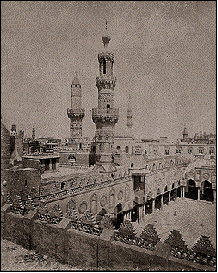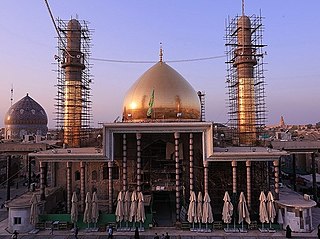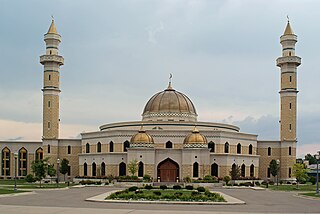
Imam is an Islamic leadership position. For Sunni Muslims, Imam is most commonly used as the title of a prayer leader of a mosque. In this context, imams may lead Islamic prayers, serve as community leaders, and provide religious guidance. Thus for Sunnis, anyone can study the basic Islamic sciences and become an Imam.
Shīʿa Islam, otherwise known as Shīʿism or as Shīʿite or Shīʿī Islam, is the second-largest branch of Islam. It holds that the Islamic prophet Muhammad designated ʿAlī ibn Abī Ṭālib as his successor (khalīfa) and the Imam after him, most notably at the event of Ghadir Khumm, but was prevented from succeeding Muhammad as the leader of the Muslims as a result of the choice made by some of Muhammad's other companions (ṣaḥāba) at Saqifah. This view primarily contrasts with that of Sunnī Islam, whose adherents believe that Muhammad did not appoint a successor before his death and consider Abū Bakr, who was appointed caliph by a group of senior Muslims at Saqifah, to be the first rightful (rāshidūn) caliph after Muhammad. Adherents of Shīʿa Islam are called Shīʿa Muslims, Shīʿites, or simply Shīʿa, Shia, or Shīʿīs.

The Al-Azhar University is a public university in Cairo, Egypt. Associated with Al-Azhar Al-Sharif in Islamic Cairo, it is Egypt's oldest degree-granting university and is known as one of the most prestigious universities for Islamic learning. In addition to higher education, Al-Azhar oversees a national network of schools with approximately two million students. As of 1996, over 4,000 teaching institutes in Egypt were affiliated with the university.

Grand Ayatollah Sayyid Abu al-Qasim al-Musawi al-Khoei was an Iranian-Iraqi Shia marja'. Al-Khoei is considered one of the most influential twelver scholars.

Islam is the official religion of the United Arab Emirates. Of the total population, 76.9% are Muslims as of a 2010 estimate by the Pew Research Center. Although no official statistics are available for the breakdown between Sunni and Shia Muslims among noncitizen residents, media estimates suggest less than 20 percent of the noncitizen Muslim population are Shia.

Islam is the dominant religion in Egypt, with approximately 90.3% of Egyptians identifying as Muslims. The majority of Egyptian Muslims are adherents of Sunni Islam, while a small minority adhere to Shia Islam. Since 1980, Islam has served as Egypt's state religion. Due to the lack of a religious census, owing to the alleged undercounting of non-Muslim minorities in Egyptian censuses, the actual percentage of Muslims is unknown; the percentage of Egyptian Christians, who are the second-largest religious group in the country, is estimated to be between 5% and 15% of the population.

Islam in Yemen dates back to about 630AD, when it was introduced by Ali who finalized the conquest of it when Muhammad was still alive. It was during this period that the mosques in Janad and the Great Mosque of Sana'a were built. Yemenis are divided into two principal Islamic religious groups: 65% Sunni and 35% Shia. Others put the numbers of Shias at 30%. The denominations are as follows: 65% primarily of the Shafi'i and other orders of Sunni Islam. 33% of the Zaidi order of Shia Islam, 2% of the Ja'fari and Tayyibi Ismaili orders of Shia Islam. Yemen is home to the Sulaymani Bohra community, a subdivision of Tayyibi Mustali Ismailism. The Sunnis are predominantly in the south and southeast. The Zaidis are predominantly in the north and northwest whilst the Jafaris are in the main centres of the North such as Sana'a and Ma'rib. There are mixed communities in the larger cities.

Islam is the state religion in Bahrain. Due to an influx of immigrants and guest workers from non-Muslim countries, such as India, the Philippines and Sri Lanka, the overall percentage of Muslims in the country has declined since the late 20th century. Bahrain's 2010 census indicated that 70.2% of the population is Muslim. The last official census (1941) to include sectarian identification reported 52% as Shia and 48 per cent as Sunni of the Muslim population.
In Shi'a Islam the guidance of clergy and keeping such a structure holds great importance. There are several branches of Shi'ism, of which Twelver Shi'ism is by far the largest, and each of the branches has different clergy structures. Individual clerics are referred to as mullā or ākhūnd, but since those terms have developed "a somewhat pejorative connotation" since at least the 1980s, the term rūḥānī has been "promoted" as an alternative, "especially by the clerical class itself".

Al-Askari Shrine, the 'Askariyya Shrine or the Al-Askari Mosque is a Shia Muslim mosque and mausoleum in the Iraqi city of Samarra 125 km (78 mi) from Baghdad. It is one of the most important Shia shrines in the world. It was built in 944. The dome was destroyed in a bombing by Sunni extremists in February 2006 and its two remaining minarets were destroyed in another bombing in June 2007, causing widespread anger among Shias and instigation of the Iraqi Civil War between the country's Shia and Sunni factions. The remaining clock tower was also destroyed in July 2007. The dome and minarets were repaired and the mosque reopened in April 2009.

The history of Islam in Iraq goes back almost 1,400 years to the lifetime of Muhammad. Iraq's Muslims follow two distinct traditions, Shia Islam (majority) and Sunni Islam (minority).

The Islamic Center of America is a mosque located in Dearborn, Michigan, in the United States. The 120,000 sq. ft. facility is the largest mosque in North America and the oldest purpose-built Shia mosque in the United States, as well as the second oldest mosque in the United States after 'Asser El Jadeed which originally opened in 1924 in Michigan City, Indiana. Although the institution dates back to 1963, the center's current mosque opened in 2005. With its large Shia Arab population, Dearborn is often called the "heart of Islam", especially for Shi'ism, in the United States.
After the death of Muhammad in 632, a group of Muslims, who would come to be known as the Sunnis, believed that Muhammad's successor as caliph of the Islamic community should be Abu Bakr, whereas a second group of Muslims, who would come to be known as the Shias, believed that his successor should have been Ali. This dispute spread across various parts of the Muslim world, which eventually led to the Battle of Jamal and Battle of Siffin. Sectarianism based on this historic dispute intensified greatly after the Battle of Karbala, in which Husayn ibn Ali and some of his close partisans, including members and children of the household of prophet, were killed by the ruling Umayyad Caliph Yazid I, and the outcry for revenge divided the early Islamic community, albeit disproportionately, into two groups, the Sunni and the Shia. This is known today as the Islamic schism.
Hujjat al-Islam Sayyid Dr.Moustafa al-Musawi al-Qazwini is an Iraqi-American Shia Imam.
Islam is an Abrahamic monotheistic religion teaching that there is only one God (Allah) and that Muhammad is His last Messenger.

Grand Ayatollah Sayyid Abu al-Hasan al-Musawi al-Isfahani was an Iranian-Iraqi Shia marja'.

The Alavi Foundation is a public not-for-profit organization based in the United States.
Islam is both the official and majority religion in the United Arab Emirates, professed by approximately 76% of the population. The Al Nahyan and Al Maktoum ruling families adhere to Sunni Islam of Maliki school of jurisprudence. Many followers of the Hanbali school of Sunni Islam are found in Sharjah, Umm al-Quwain, Ras al-Khaimah and Ajman. Their followers include the Al Qasimi ruling family. Other religions represented in the country including Christianity, Hinduism, Buddhism, Zoroastrians, Druze, Baha'i Judaism and Sikhism are practiced by non-nationals.

The Islamic Society of Greater Houston (ISGH) is a system of mosques in Greater Houston. It is headquartered at the Eastside Main Center in Upper Kirby in Houston.

As of 2012, the city of Houston has the largest Muslim population in Texas and the largest Muslim population in the Southern United States. That year, Kate Shellnut of the Houston Chronicle wrote that "Some estimate that Muslims make up 1.2 percent of the city's population." As of 2012 the estimated population of Muslims in Houston was around 63,000. As of today, there are over 209 mosques and storefront religious centers, with the largest being the Al-Noor Mosque of the Islamic Society of Greater Houston (ISGH).














